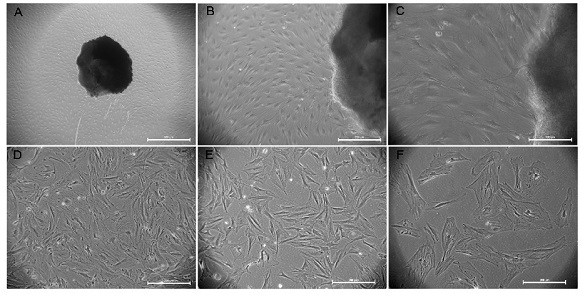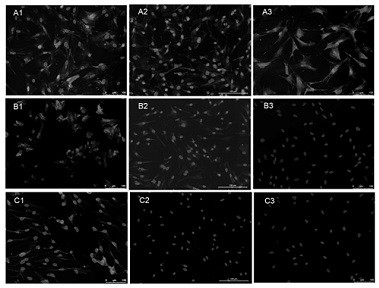A kind of in vitro culture and purification method of perineurial cells
A purification method and in vitro culture technology, applied in the field of in vitro culture and purification of perineurial cells, can solve the problems of large damage to perineurial cells, difficulty in moving out of perineurial cells, and multiple suspended debris, so as to promote migration The effects of export and proliferation, promotion of migration ability, and shortening of culture time
- Summary
- Abstract
- Description
- Claims
- Application Information
AI Technical Summary
Problems solved by technology
Method used
Image
Examples
Embodiment 1
[0039] Example 1: Isolation, culture, purification and identification of perineurial cells
[0040] Steps: Take about 100g of SD rats, take the sciatic nerve, carefully peel off the epineurium under a dissecting microscope, cut the nerve bundle into about 1mm segments and cut them in half longitudinally, remove the nerve fibers from the cut surface as much as possible, and separate them to obtain Sheet-shaped perineurium, washed with pre-cooled sterile PBS, quickly placed in a cell culture plate, in saturated humidity, 5% CO 2 , Cultured in a 37°C incubator. Thereafter, the medium was changed every 3 days, and cultured for about 10 days. When many cells crawled out around the tissue block, they were passaged, observed under an inverted phase-contrast microscope, and their growth and proliferation were recorded.
[0041] The complete medium of perineurial cells was DMEM / F12, containing 10% fetal bovine serum, 2 μmol / L Forskolin (Sigma) and 12.5ng / mL Heregulin-β1 (Peprotech), a...
Embodiment 2
[0044] Example 2: Purification and identification of "time-limited digestion-differential attachment" of perineurial cells
[0045] 1. Removal of Schwann cells by time-limited digestion
[0046] Principle: When the cells grow to confluence, according to the difference in the reaction time of the cells to trypsin, the time-limited digestion method is used to separate Schwann cells from perineurial cells and fibroblasts. Schwann cells are sensitive to trypsin, which takes about 10 seconds, while it takes a long time for trypsin to digest perineurial cells and fibroblasts, which takes about 2-3 minutes.
[0047] Steps: Add 0.25% trypsin to the culture plate and stay for 10 seconds, then quickly add the complete medium of perineurial cells to stop digestion. At this time, the Schwann cells become round, shake the cell plate gently, the Schwann cells fall off, and the perineurial cells Cells and fibroblasts remain attached to the bottom of the plate.
[0048] 2. Initial Fibroblas...
Embodiment 3
[0052] Example 3: Purification and identification of "time-limited digestion-differential attachment-chemical drugs" of perineurial cells
[0053]Principle: Cytarabine is a pyrimidine anti-metabolic drug that affects DNA synthesis and replication by inhibiting DNA polymerase, and mainly acts on the S proliferation phase of cells. It inhibits the growth of rapidly proliferating cells, such as fibroblasts, while having little effect on slow proliferating cells, such as perineurial cells. According to the speed of fibroblast adhesion and division and proliferation, it usually begins to proliferate 24 hours after inoculation, which is earlier than the division and proliferation speed of perineurial cells. Therefore, choosing to add appropriate concentration of cytarabine to act on the remaining fibroblasts after re-seeding the cells for 24 hours can fully improve the purity of the perineurial cells, and has little effect on the growth state of the perineurial cells. .
[0054] s...
PUM
 Login to View More
Login to View More Abstract
Description
Claims
Application Information
 Login to View More
Login to View More - R&D
- Intellectual Property
- Life Sciences
- Materials
- Tech Scout
- Unparalleled Data Quality
- Higher Quality Content
- 60% Fewer Hallucinations
Browse by: Latest US Patents, China's latest patents, Technical Efficacy Thesaurus, Application Domain, Technology Topic, Popular Technical Reports.
© 2025 PatSnap. All rights reserved.Legal|Privacy policy|Modern Slavery Act Transparency Statement|Sitemap|About US| Contact US: help@patsnap.com



